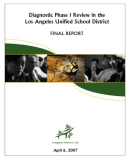An unsubtle reminder sent to 4LAKids by an Elementary Librarian: DIAGNOSTIC PHASE I REPORT OF THE LAUSD
by smf for 4LAKids News
ev·er·green adj \ˈe-vər-ˌgrēn\
2: retaining freshness or interest : perennial

As dust is a pathogen and promotes asthma, it's a health hazard ...so perhaps someone should dust it off and read it.
Let's start, gentle reader, with you and me.
By the way the report isn't just on a Beaudry bookshelf ...or reproduced below.
Our librarian found it on the internet – on the Daily News site. Thank you Daily News for making what would take a trip downtown, a building pass and a parking validation (both hard hard to come by) - plus a knowledge of where the bookshelves of ignored binders are – easier to find. [The Fabulous Firewall of Forbearance has been known to be sometimes effective against both the Freedom of Information Act and the Ralph M. Brown Act].
As to the LAUSD Repository of Binders I'm picturing something like the closing scene from Raiders of the Lost Ark; in there also is my Permanent Record – the one in which boys vice principals in the '60's made daily entries. And thank you Elementary School Librarian – your knowledge and skill in locating stuff will prove valuable in your next job …because LAUSD and your union have not reached an agreement – that pink slip you got is very, very real!
The EVERGREEN REPORT EXECUTIVE SUMMARY hits the ground running:
Numerous reports have been written about the organization and management of the Los Angeles Unified School District. Among the most significant reports written in the 21st Century, which focus on a transforming and restructuring the organizational structure, are the following four studies:
• Multidistrict Plan for Transforming the Los Angeles Unified School District, also referred to as the Cortines Plan (March 2000); (smf: In Cortines defense, he did come back and try to implement the plan again ...but the economy got in the way)
• Review of the Organizational Structure and Operations of the Los Angeles Unified School District (The Council of Great City Schools, January 2006);
• President’s Joint Commission on LAUSD Governance (July 2006); and
• California State Audit Report (September 2006).
…..The majority of the above reform efforts were either discarded, not embraced by senior managers, or placed temporarily on hold with the transition in leadership. For example, the Instructional Guidance Plan, which was to be developed by the three education divisions (elementary, secondary, and educational services), was only drafted by the elementary division.
Moreover, a Chief Academic Officer (CAO) has yet to be hired to begin the challenge of breaking down the silo mentality of the three educational divisions and begin to build an integrated pre-K through adult system for instructional continuity.
smf: The Chief Academic Officer actually has been hired – but 4LAKids wonders if she is aware that it's her responsibility to “break down the silo mentality of the three educational divisions and begin to build an integrated pre-K through adult system for instructional continuity”.
The Executive Summary continues:
In reviewing the major reform reports completed in the last six years, many common themes emerge, including:
-
LAUSD is not organized to ensure both vertical and horizontal collaboration and cooperation, or a matrix design, in a cohesive management structure.
-
The centralized structure of the organization is not conducive to the effective implementation of the local district concept. Although this decentralized concept has been questioned by some, the new Superintendent appears to support this type of organizational structure. Yet, local district superintendents have not been given the authority, responsibility, or human/fiscal resources to accomplish their mission. The duties of the central office staff and the local district staff must be clearly articulated.
-
Board-adopted policies either do not exist, are outdated, or, in many cases, administrators are not aware of the adoption of a Board policy; the Board’s Policy Manual has not been updated in decades.
-
The roles of the Board of Education as the policymaking governing body, and the Superintendent/CEO as the implementor of Board policy and manager of staff, are not defined. Consequently, the governing body and individual Board members are heavily involved in management operations and issues, and not focused on policy.
-
There is no linkage between planning and budgeting. Consequently, there is little evidence that fiscal resources are being directed to support district goals. A measurement of the impact of past organizational changes on staffing and costs has not occurred.
-
Further, performance metrics with goals and qualificable benchmarks do not exist.
-
Fiduciary issues are widespread, including the lack of internal controls, accurate cost allocations, and high costs for benefits that the district may no longer be able to afford
-
The lack of accountability is pervasive throughout the organization at all levels.
-
The current culture in LAUSD is one typified by not responding to priorities and deadlines, and there is no sense of urgency among managers.
While obvious, this is pretty critical criticism – those bullets hit close to home.One can see why the subjects of the report were loath to implement its recommendations and why there were no subsequent phases after Phase I.
It becomes obvious (or perhaps oblivious) that we can add The Evergreen Report to the list of the previous 'discarded, not embraced, or placed temporarily on hold' four reports.
Also worth noting: the Evergreen Report keeps referring to 'the new superintendent'. That was three superintendents ago. But who’s counting?
The Evergreen Report (2007)
No comments:
Post a Comment